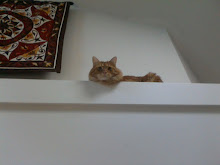
After a bit of experimentation and thought, I decided not to use single strips of card for the majority of the tiling but instead to make individual rectangles which were then glued into place. Believe me, it doesn't take that long to do! Each shingle/tile is measured out in a grid pattern to the dimensions required and then cut out en-masse using scissors. If you find you have too much after the work is done, put the excess in storage for the next roofing project.
Only the eaves are single pieces, mainly to create a base for the rest of the assembly. I glued this in place with impact adhesive and waited until it was completely firm before starting on the next stage. Working up toward the turret I dampened the strip and the thicker card beneath with a quick stroke from a brush then applied a light smear of PVA adhesive to the top half of the strip and the area of base card directly above. The area of the angles was kept clear as this would be where the ridge tiles would go.
Using the dampened end of a matchstick to pick up the tiles, I dabbed them into place one at a time, building up a rhythm and working fairly quickly to complete a row. The PVA soaks into the card quite quickly and stays wet enough for only a few minutes to allow the tiles to be slid into place if they're not quite correctly aligned. Although it doesn't matter too much if the tiles show gaps or a slight crookedness, the overall alignment is crucial. It's best to mark out lines on the base card to indicate where the rows should go, and as each new side is begun it pays to just check that the rows match those on the adjoining faces.
Once the tiling was in place, the curved ridges were added. These were simplicity itself to make, being just thin rolls of modelling clay cut to length and pressed into the card until firm. The tiles were shaped by rolling over the wet clay at an angle with a length of plastic tubing.
The card I used has a glossy side but this doesn't matter as a thin layer of diluted PVA was brushed over the whole surface, hardening it and preparing it for painting. When this has dried and set it's quite hard, a useful trait for what will be a wargaming model.
The overall effect is slightly rustic, as I wanted the tower to be a feature of some provincial town. Below the eaves can be seen the half-timbered gallery with the "wooden" beams cut from more thin card and given a light wash of diluted general purpose filler.





1 comment:
It looks good . . . and thank you for the detailed description of the construction process.
-- Jeff
Post a Comment